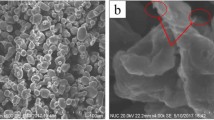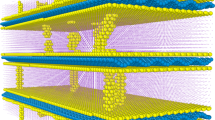Abstract
Owing to its distinguished mechanical stiffness and strength, graphene has become an ideal reinforcing material in kinds of composite materials. In this work, the graphene (reduced graphene oxide) reinforced aluminum (Al) matrix composites were fabricated by flaky powder metallurgy. Tensile tests of pure Al matrix and graphene/Al composites with bioinspired layered structures are conducted. By means of an independently developed Python-based structural modeling program, three-dimensional microscopic structural models of graphene/Al composites can be established, in which the size, shape, orientation, location and content of graphene can be reconstructed in line with the actual graphene/Al composite structures. Elastoplastic mechanical properties, damaged materials behaviors, graphene-Al interfacial behaviors and reasonable boundary conditions are introduced and applied to perform the simulations. Based on the experimental and numerical tensile behaviors of graphene/ Al composites, the effects of graphene morphology, graphene-Al interface, composite configuration and failure behavior within the tensile mechanical deformations of graphene/ Al composites can be revealed and indicated, respectively. From the analysis above, a good understanding can be brought to light for the deformation mechanism of graphene/Al composites.
摘要
石墨烯具有优异的机械性能, 已成为众多复合材料中的理想增强体材料. 本研究采用片状粉末冶金方法制备了具有仿生叠层结构的石墨烯/铝基复合材料, 同时对纯铝基体与石墨烯/铝基复合材料进行了拉伸试验. 通过基于Python语言自主研发的复合材料结构建模程序, 可以有效建立石墨烯/铝基复合材料的三维复合结构模型, 并实现石墨烯尺寸、形貌、取向、位置与含量等可控重构分布. 通过引入组分材料力学性能、损伤行为、界面行为及边界条件等实现了石墨烯/铝基复合材料的拉伸行为模拟, 并揭示了石墨烯形貌、石墨烯/铝界面、复合构型与失效行为等复合因素的影响规律, 对理解石墨烯/铝基复合材料的变形机理提供了有力依据.
Similar content being viewed by others
References
Geim AK, Novoselov KS. The rise of graphene. Nat Mater, 2007, 6: 183–191
Novoselov KS, Fal'ko VI, Colombo L, et al. A roadmap for graphene. Nature, 2012, 490: 192–200
Daniels C, Horning A, Phillips A, et al. Elastic, plastic, and fracture mechanisms in graphene materials. J Phys-Condens Matter, 2015, 27: 373002
Liu F, Ming P, Li J. Ab initio calculation of ideal strength and phonon instability of graphene under tension. Phys Rev B, 2007, 76: 064120
Lee C, Wei X, Kysar JW, et al. Measurement of the elastic properties and intrinsic strength of monolayer graphene. Science, 2008, 321: 385–388
Balandin AA. Thermal properties of graphene and nanostructured carbon materials. Nat Mater, 2011, 10: 569–581
Morozov SV, Novoselov KS, Katsnelson MI, et al. Giant intrinsic carrier mobilities in graphene and its bilayer. Phys Rev Lett, 2008, 100: 016602
Porwal H, Grasso S, Reece MJ. Review of graphene–ceramic matrix composites. Adv Appl Ceramics, 2013, 112: 443–454
Das TK, Prusty S. Graphene-based polymer composites and their applications. Polymer-Plastics Tech Eng, 2013, 52: 319–331
Tjong SC. Recent progress in the development and properties of novel metal matrix nanocomposites reinforced with carbon nanotubes and graphene nanosheets. Mater Sci Eng-R-Rep, 2013, 74: 281–350
Rafiee MA, Rafiee J, Wang Z, et al. Enhanced mechanical properties of nanocomposites at low graphene content. ACS Nano, 2009, 3: 3884–3890
Wan C, Chen B. Reinforcement and interphase of polymer/graphene oxide nanocomposites. J Mater Chem, 2012, 22: 3637–3646
Chen LY, Konishi H, Fehrenbacher A, et al. Novel nanoprocessing route for bulk graphene nanoplatelets reinforced metal matrix nanocomposites. Scripta Mater, 2012, 67: 29–32
Lin D, Richard Liu C, Cheng GJ. Single-layer graphene oxide reinforced metal matrix composites by laser sintering: Microstructure and mechanical property enhancement. Acta Mater, 2014, 80: 183–193
Chu K, Jia C. Enhanced strength in bulk graphene-copper composites. Phys Status Solidi A, 2014, 211: 184–190
Liu L, Zhang J, Zhao J, et al. Mechanical properties of graphene oxides. Nanoscale, 2012, 4: 5910–5916
Dikin DA, Stankovich S, Zimney EJ, et al. Preparation and characterization of graphene oxide paper. Nature, 2007, 448: 457–460
Park S, Ruoff RS. Chemical methods for the production of graphenes. Nat Nanotech, 2009, 4: 217–224
Avouris P, Dimitrakopoulos C. Graphene: synthesis and applications. Mater Today, 2012, 15: 86–97
Montazeri A, Rafii-Tabar H. Multiscale modeling of graphene- and nanotube-based reinforced polymer nanocomposites. Phys Lett A, 2011, 375: 4034–4040
Suk JW, Piner RD, An J, et al. Mechanical properties of monolayer graphene oxide. ACS Nano, 2010, 4: 6557–6564
Paci JT, Belytschko T, Schatz GC. Computational studies of the structure, behavior upon heating, and mechanical properties of graphite oxide. J Phys Chem C, 2007, 111: 18099–18111
Parashar A, Mertiny P. Multiscale model to investigate the effect of graphene on the fracture characteristics of graphene/polymer nanocomposites. Nanoscale Res Lett, 2012, 7: 595
Dai G, Mishnaevsky Jr. L. Graphene reinforced nanocomposites: 3D simulation of damage and fracture. Comp Mater Sci, 2014, 95: 684–692
Azoti WL, Elmarakbi A. Multiscale modelling of graphene platelets- based nanocomposite materials. Composite Struct, 2017, 168: 313–321
Jiang L, Li Z, Fan G, et al. The use of flake powder metallurgy to produce carbon nanotube (CNT)/aluminum composites with a homogenous CNT distribution. Carbon, 2012, 50: 1993–1998
Li Z, Fan G, Tan Z, et al. Uniform dispersion of graphene oxide in aluminum powder by direct electrostatic adsorption for fabrication of graphene/aluminum composites. Nanotechnology, 2014, 25: 325601
Young RJ, Kinloch IA, Gong L, et al. The mechanics of graphene nanocomposites: a review. Composites Sci Tech, 2012, 72: 1459–1476
Arsenault RJ, Shi N. Dislocation generation due to differences between the coefficients of thermal expansion. Mater Sci Eng, 1986, 81: 175–187
Yoon D, Son YW, Cheong H. Negative thermal expansion coefficient of graphene measured by Raman spectroscopy. Nano Lett, 2011, 11: 3227–3231
Su Y, Li Z, Jiang L, et al. Computational structural modeling and mechanical behavior of carbon nanotube reinforced aluminum matrix composites. Mater Sci Eng-A, 2014, 614: 273–283
Liu Z, Zhang SM, Yang JR, et al. Interlayer shear strength of single crystalline graphite. Acta Mech Sin, 2012, 28: 978–982
Feng S, Guo Q, Li Z, et al. Strengthening and toughening mechanisms in graphene-Al nanolaminated composite micro-pillars. Acta Mater, 2017, 125: 98–108
Acknowledgements
The authors acknowledge the financial supports by the National Natural Science Foundation (51501111, 51131004), the Ministry of Science and Technology of China (2016YFE0130200), Science & Technology Committee of Shanghai (14DZ2261200, 1452 0710100 and 14JC14033 00) and 111 Project (B16032).
Author information
Authors and Affiliations
Corresponding author
Additional information
Author contributions Zhang D and Su Y designed and directed the overall study. Sample preparation, tensile tests and SEM, TEM observation were carried out by Li Z, Yu Y and Zhao L, respectively. Su Y wrote the manuscript and discussed the results and analyzed the data with Li ZQ, Guo Q and Xiong D.
Conflict of interest The authors declare that they have no conflict of interest.
Yishi Su received his PhD from University of Technology of Troyes, France in 2012, and joined Professor Di Zhang’s group as a post-doctor and assistant professor at Shanghai Jiao Tong University since 2012, 2014. His research interests focus on biomimetic metal matrix composites and materials genome computation.
Di Zhang received his PhD from Osaka University, Japan. He is now a Chair Professor of Materials Science and Engineering at Shanghai Jiao Tong University in China (since 1994), the director of State Key Lab of Metal Matrix Composites and the Institute of Composite Materials at SJTU (since 2003), and the Professor of Chang Jiang Scholars Program (since 2001). Prof. Zhang has published more than 200 peer reviewed academic articles, 1 English academic book on morphology-genetic materials, and attended international conferences as invited speakers for 47 times. His research interests include the process of advanced metal matrix composites and the basic and applied research on biomimetic morphology-genetic materials.
Rights and permissions
About this article
Cite this article
Su, Y., Li, Z., Yu, Y. et al. Composite structural modeling and tensile mechanical behavior of graphene reinforced metal matrix composites. Sci. China Mater. 61, 112–124 (2018). https://doi.org/10.1007/s40843-017-9142-2
Received:
Accepted:
Published:
Issue Date:
DOI: https://doi.org/10.1007/s40843-017-9142-2




